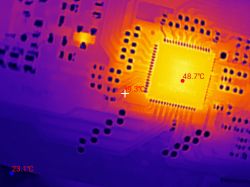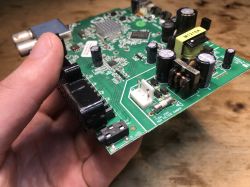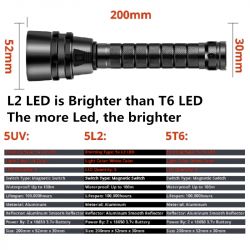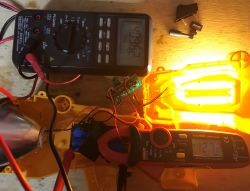
Hello, I will present here a short review and teardown of a Chinese USB rechargeable flashlight that can also be used as a power bank. After opening the case, I will try to analyze the operation of the circuit from the inside and finally I will present a different, slightly better flashlight which I am really happy with the purchase.
Purchase of a flashlight, first impression
I found the product on the web under the slogan "5000LM 1500M Powerful Outdoor LED Spotlight 12000mAh USB Phone Power Bank Rechargeable Strong Searching Flashlight". I ordered it in promotion when a shipment directly from the Czech Republic was available:

I paid about $ 15. Promotional graphics:
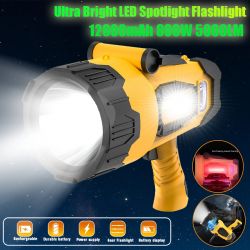
At the very beginning, you can probably guess that these 800W and 12000mAh are such an unusual form of marketing that is not reflected in reality. Well, but we will check how it really is ...
Really, 800W? This is such a portable microwave oven?
In addition, the supply of watts does not accurately reflect how well it will shine, LEDs have different efficiency.
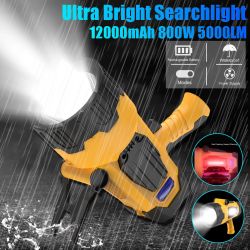

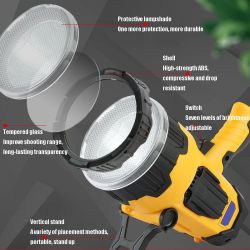
Received kit:
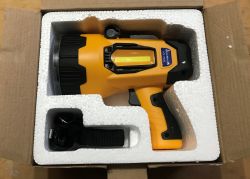
After wearing the strap:
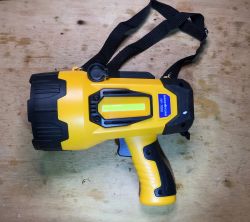
The plastic itself from the case, however, is quite weak, as in the cheapest Chinese products.
The flashlight is ready for operation after taking it out of the packaging. It actually has different modes of operation, although the front LED seems to glow quite dimly . The side LED is relatively strong, it also has a red light mode.
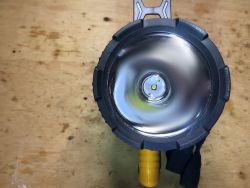
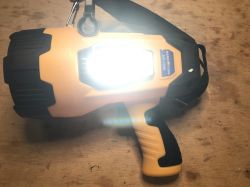
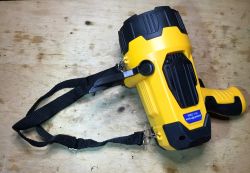
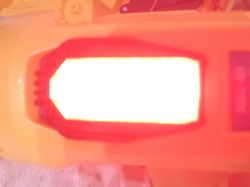
In addition, there are several operating modes, light, dark, flashing, all switched with this one button (a long press turns it off / on, a short press turns on the next mode).
The USB socket on the housing provides a stable 5V to about 0.9A:
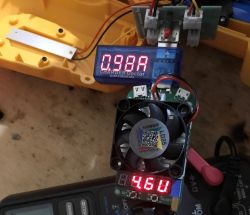
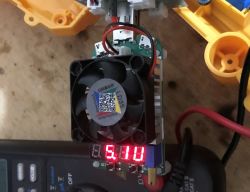
The inside of the flashlight
I started the teardown by dismantling rubber (actually rubber - it's not just plastic ornaments) protections:
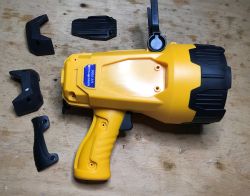
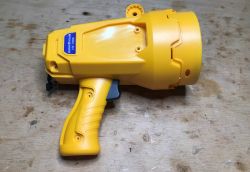
Ultimately, however, one screw holding the housing is visible after removing the foot:
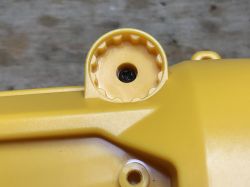
the second after removing the front rubber protection:
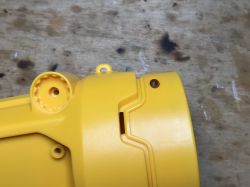
Interior:
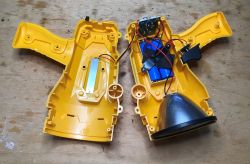
Button:
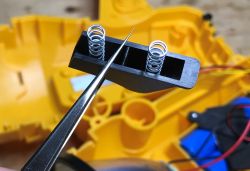
There is one electronics board inside, everything is connected to it via connectors:
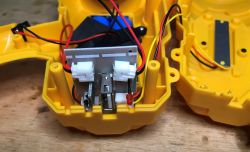
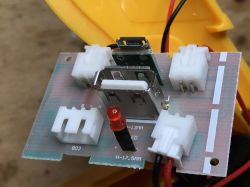
It is strange that the manufacturer allowed himself to buy connectors. Probably the only advantage of this product. Wouldn't it be cheaper to solder the cables to the PCB?
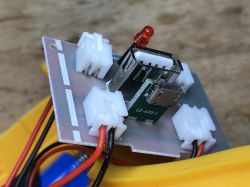
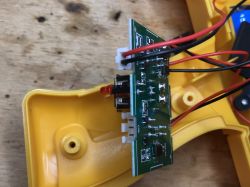
The cells inside are ICR 18650 2200mAh 3.7V and are fully replaceable which is a plus. You can't trust the capacity printed on them, but even if you trust it, it comes out of 4400mAh and not the promised "12000mAh". Of course...
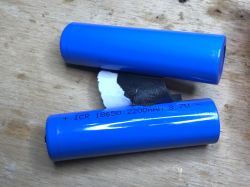
Several measurements
Out of curiosity, I checked approximately what current at what voltage is taken from the cells in the case of the two brightest modes of operation:

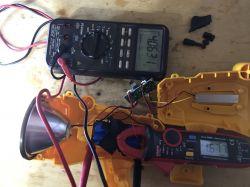
At 4V, the side LEDs take 1.3A and the front LEDs take 1.7A. There is not even 8W, let alone the mythical 800W ... here the seller really "flew away".
Tile on the inside
I put the most important information and connections on the photo of the plate. I think this is enough to understand how the system works.
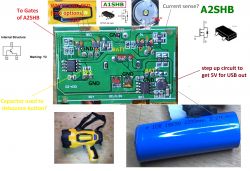
The system consists of:
- an unsigned element in the SOIC8 housing that looks like a microcontroller (a button is connected to it, it turns on the transistors mentioned)
- transistor Y2 (actually: SS8550; to turn on the side red light)
- MOSFET with P channel A1SHB (actually: HM2301B, Si2301DS; for switching the side white light)
- two MOSFETs with N channel A2SHB (actually: SI2302DS, GMS2302AL; connected with leads, to switch on the main LED).
- an unsigned element in the SOIC8 housing that looks like a charge controller / step up converter, through it the current goes from VIN to the battery, and from the battery to 5V (there is a larger 2R2 choke, which suggests that it is a step up converter, of course you also need a rectifying diode and a keying transistor, but they are probably integrated in this system)
From the smallest detail, I can see that a capacitor was used here to eliminate the vibration of the main button contacts, and I think that's it.
I do not like this system a bit, I do not see any protection against over-discharge of the cell here ... unless this microcontroller does something in this direction, or maybe the Chinese assumed that the voltage drop on the diodes will not allow the cell to discharge? I have the impression that the LEDs here have to be current-controlled, which is also evidenced by the presence1? shunt resistors, which are used to measure the current (by measuring the voltage drop across them) using the ADC from the flashlight controller. If this is the case, then until a certain point we will not see that the flashlight shines darker with the discharge of the cells, because the current flowing through the LEDs is constant - unless the cell is just discharged excessively ...
The system could be analyzed more deeply, measurements could be taken, but I decided that it was enough for me to satisfy my curiosity.
Is there any other flashlight worth recommending?
I think that everyone can agree that the flashlight in this topic is generally of poor quality. So one could wonder if you can buy something better at a similar price?
Of course, yes - some time ago I bought a NexTool NE20030 flashlight which I really appreciate .
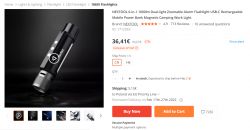
When I was buying it, it was shipping from the Czech Republic and it was a bit cheaper ...

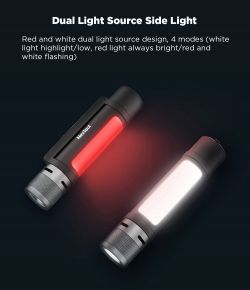
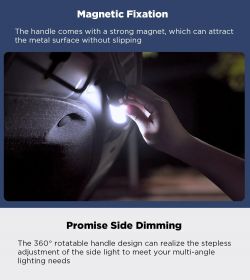
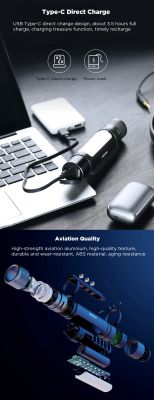

Initially, I even wanted to do a test and a photo gallery from inside to this section, but ... I am not able to disassemble it (no screws, hooks, anything?), It's a pity to destroy it:
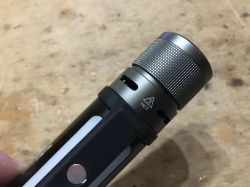
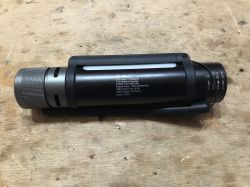
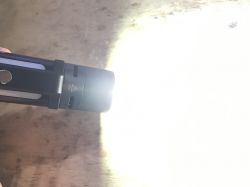
Here, of course, the housing is made of metal and solid. Magnets for putting away the flashlight too, I keep it always "glued" to the metal leg of the table.
This flashlight is really strong, it still serves me when I go to the basement or the attic. The beam of light is so strong that when you spend a moment in one place, it heats up.
Summary
I didn't expect much from this flashlight, and I ordered it out of curiosity, but I still think it is weak. Maybe it is because of the aforementioned NexTool NE20030, which I praise myself quite a bit. However, it turned out that the lantern from this theme is more of a toy that focuses on appearance and appearance. This main front LED is really weak. In addition, I have some reservations about the layout from the inside. Probably its only advantages are that the cells are replaceable, so it is not such a total disposable. It's good that I was buying it on promotion with shipping from the Czech Republic and not for the full price. Maybe someday it will be useful for something more than shining a moderately bright beam of light and, for example, I will remake the system and put more cells and a stronger LED inside? There is room for more ....
As for 12000mAh - of course, the seller lied. The cells themselves (if you believe the label) have 2 * 2200mAh. But to check it, you didn't even have to open the case, just weigh it or just know how it ends with buying such a miracle from China.
Unfortunately, I have nothing to measure the light level itself.
To sum up, I will not use this "flashlight" myself, especially since I have my own Nextool, but I think that as a toy for a young one (not mine, not this age yet), it may work well.
Cool? Ranking DIY Helpful post? Buy me a coffee.



